Quick filters:
Phoenician clothing Stock Photos and Images
 Iberian Peninsula. Ancient History. Phoenicians. Figures 1 to 5: illustrations inspired by antiquities from the Cerro de los Santos. Figure 6: Phoenician from a small lamp in the Museum of Tarragona. Chromolithography. Historia General de España, by Modesto Lafuente. Volume I. Published in Barcelona, 1877. Stock Photohttps://www.alamy.com/image-license-details/?v=1https://www.alamy.com/iberian-peninsula-ancient-history-phoenicians-figures-1-to-5-illustrations-inspired-by-antiquities-from-the-cerro-de-los-santos-figure-6-phoenician-from-a-small-lamp-in-the-museum-of-tarragona-chromolithography-historia-general-de-espaa-by-modesto-lafuente-volume-i-published-in-barcelona-1877-image465734793.html
Iberian Peninsula. Ancient History. Phoenicians. Figures 1 to 5: illustrations inspired by antiquities from the Cerro de los Santos. Figure 6: Phoenician from a small lamp in the Museum of Tarragona. Chromolithography. Historia General de España, by Modesto Lafuente. Volume I. Published in Barcelona, 1877. Stock Photohttps://www.alamy.com/image-license-details/?v=1https://www.alamy.com/iberian-peninsula-ancient-history-phoenicians-figures-1-to-5-illustrations-inspired-by-antiquities-from-the-cerro-de-los-santos-figure-6-phoenician-from-a-small-lamp-in-the-museum-of-tarragona-chromolithography-historia-general-de-espaa-by-modesto-lafuente-volume-i-published-in-barcelona-1877-image465734793.htmlRM2J1M1DD–Iberian Peninsula. Ancient History. Phoenicians. Figures 1 to 5: illustrations inspired by antiquities from the Cerro de los Santos. Figure 6: Phoenician from a small lamp in the Museum of Tarragona. Chromolithography. Historia General de España, by Modesto Lafuente. Volume I. Published in Barcelona, 1877.
 Fashion, the clothes of Mykenae, Crete and Cyprus, Aegean and Phoenician culture, 2000-500 BC, two snake goddesses with blouse Stock Photohttps://www.alamy.com/image-license-details/?v=1https://www.alamy.com/fashion-the-clothes-of-mykenae-crete-and-cyprus-aegean-and-phoenician-culture-2000-500-bc-two-snake-goddesses-with-blouse-image226954563.html
Fashion, the clothes of Mykenae, Crete and Cyprus, Aegean and Phoenician culture, 2000-500 BC, two snake goddesses with blouse Stock Photohttps://www.alamy.com/image-license-details/?v=1https://www.alamy.com/fashion-the-clothes-of-mykenae-crete-and-cyprus-aegean-and-phoenician-culture-2000-500-bc-two-snake-goddesses-with-blouse-image226954563.htmlRMR56JT3–Fashion, the clothes of Mykenae, Crete and Cyprus, Aegean and Phoenician culture, 2000-500 BC, two snake goddesses with blouse
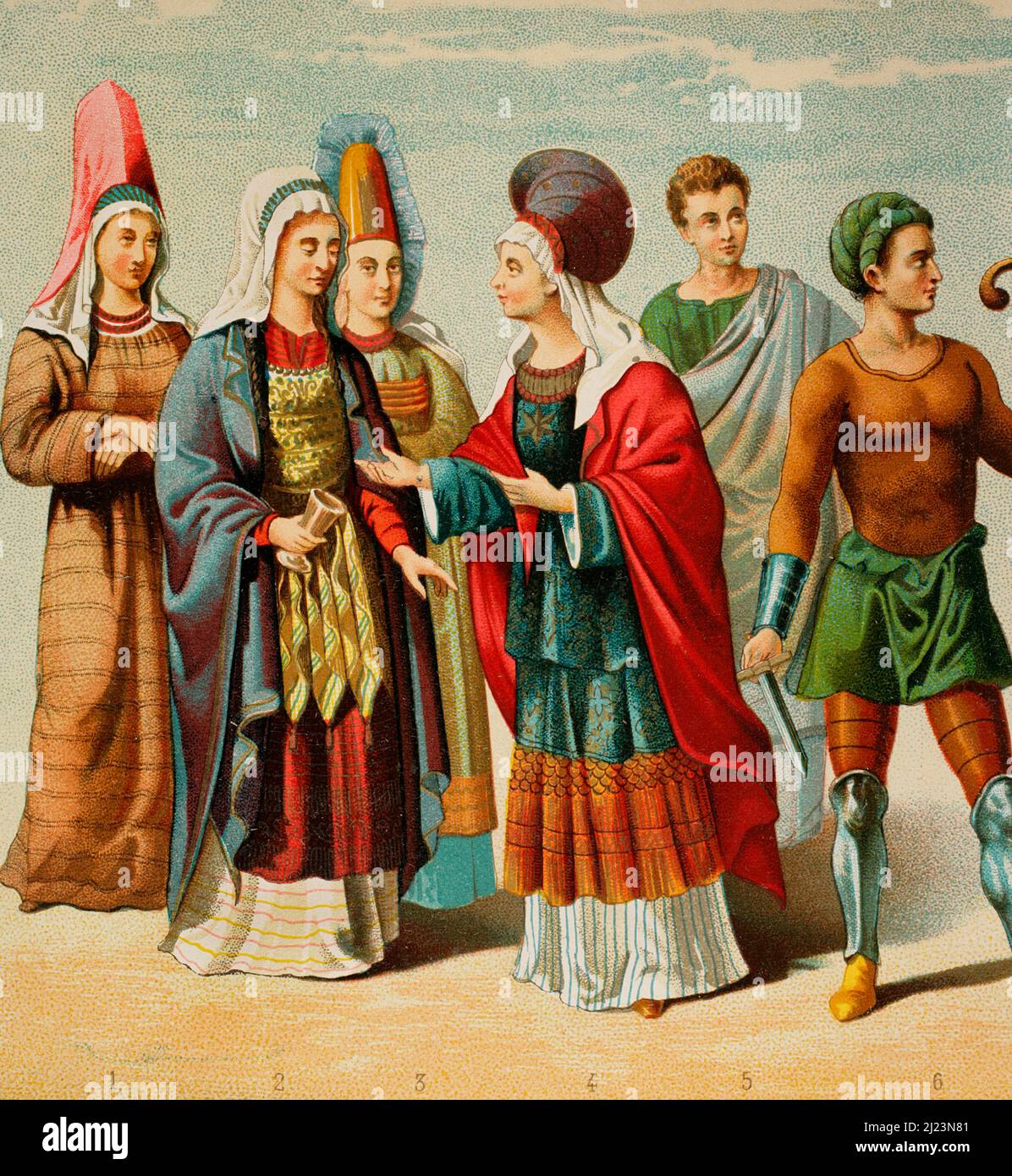 Iberian Peninsula. Ancient History. Phoenicians. Figures 1 to 5: illustrations inspired by antiquities from the Cerro de los Santos. Figure 6: Phoenician from a small lamp in the Museum of Tarragona. Chromolithography. Historia General de España, by Modesto Lafuente. Volume I. Published in Barcelona, 1877. Stock Photohttps://www.alamy.com/image-license-details/?v=1https://www.alamy.com/iberian-peninsula-ancient-history-phoenicians-figures-1-to-5-illustrations-inspired-by-antiquities-from-the-cerro-de-los-santos-figure-6-phoenician-from-a-small-lamp-in-the-museum-of-tarragona-chromolithography-historia-general-de-espaa-by-modesto-lafuente-volume-i-published-in-barcelona-1877-image465991793.html
Iberian Peninsula. Ancient History. Phoenicians. Figures 1 to 5: illustrations inspired by antiquities from the Cerro de los Santos. Figure 6: Phoenician from a small lamp in the Museum of Tarragona. Chromolithography. Historia General de España, by Modesto Lafuente. Volume I. Published in Barcelona, 1877. Stock Photohttps://www.alamy.com/image-license-details/?v=1https://www.alamy.com/iberian-peninsula-ancient-history-phoenicians-figures-1-to-5-illustrations-inspired-by-antiquities-from-the-cerro-de-los-santos-figure-6-phoenician-from-a-small-lamp-in-the-museum-of-tarragona-chromolithography-historia-general-de-espaa-by-modesto-lafuente-volume-i-published-in-barcelona-1877-image465991793.htmlRM2J23N81–Iberian Peninsula. Ancient History. Phoenicians. Figures 1 to 5: illustrations inspired by antiquities from the Cerro de los Santos. Figure 6: Phoenician from a small lamp in the Museum of Tarragona. Chromolithography. Historia General de España, by Modesto Lafuente. Volume I. Published in Barcelona, 1877.
 Clay pots from Cyprus prehistoric times found by Luigi Palma di Cesnola. Ancient Greece, Europe. Old 19th century engraved illustration from El Mundo Ilustrado 1880 Stock Photohttps://www.alamy.com/image-license-details/?v=1https://www.alamy.com/clay-pots-from-cyprus-prehistoric-times-found-by-luigi-palma-di-cesnola-ancient-greece-europe-old-19th-century-engraved-illustration-from-el-mundo-ilustrado-1880-image434915540.html
Clay pots from Cyprus prehistoric times found by Luigi Palma di Cesnola. Ancient Greece, Europe. Old 19th century engraved illustration from El Mundo Ilustrado 1880 Stock Photohttps://www.alamy.com/image-license-details/?v=1https://www.alamy.com/clay-pots-from-cyprus-prehistoric-times-found-by-luigi-palma-di-cesnola-ancient-greece-europe-old-19th-century-engraved-illustration-from-el-mundo-ilustrado-1880-image434915540.htmlRM2G7G35T–Clay pots from Cyprus prehistoric times found by Luigi Palma di Cesnola. Ancient Greece, Europe. Old 19th century engraved illustration from El Mundo Ilustrado 1880
 Saint Leonce of Tripoli, Phoenician soldier and martyr, 4th century. In Byzantine military costume of the 11th century. From a painting by Dominique Papety made in the Agia Lavra Monastery, Mt. Athos, now in the Louvre. Saint Leonce, Empire de Byzance, XIe Siecle. Chromolithograph by Emile Beau after an illustration by Claudius Joseph Ciappori from Charles Louandre’s Les Arts Somptuaires, The Sumptuary Arts, Hangard-Mauge, Paris, 1858. Stock Photohttps://www.alamy.com/image-license-details/?v=1https://www.alamy.com/saint-leonce-of-tripoli-phoenician-soldier-and-martyr-4th-century-in-byzantine-military-costume-of-the-11th-century-from-a-painting-by-dominique-papety-made-in-the-agia-lavra-monastery-mt-athos-now-in-the-louvre-saint-leonce-empire-de-byzance-xie-siecle-chromolithograph-by-emile-beau-after-an-illustration-by-claudius-joseph-ciappori-from-charles-louandres-les-arts-somptuaires-the-sumptuary-arts-hangard-mauge-paris-1858-image499567693.html
Saint Leonce of Tripoli, Phoenician soldier and martyr, 4th century. In Byzantine military costume of the 11th century. From a painting by Dominique Papety made in the Agia Lavra Monastery, Mt. Athos, now in the Louvre. Saint Leonce, Empire de Byzance, XIe Siecle. Chromolithograph by Emile Beau after an illustration by Claudius Joseph Ciappori from Charles Louandre’s Les Arts Somptuaires, The Sumptuary Arts, Hangard-Mauge, Paris, 1858. Stock Photohttps://www.alamy.com/image-license-details/?v=1https://www.alamy.com/saint-leonce-of-tripoli-phoenician-soldier-and-martyr-4th-century-in-byzantine-military-costume-of-the-11th-century-from-a-painting-by-dominique-papety-made-in-the-agia-lavra-monastery-mt-athos-now-in-the-louvre-saint-leonce-empire-de-byzance-xie-siecle-chromolithograph-by-emile-beau-after-an-illustration-by-claudius-joseph-ciappori-from-charles-louandres-les-arts-somptuaires-the-sumptuary-arts-hangard-mauge-paris-1858-image499567693.htmlRM2M0N7K9–Saint Leonce of Tripoli, Phoenician soldier and martyr, 4th century. In Byzantine military costume of the 11th century. From a painting by Dominique Papety made in the Agia Lavra Monastery, Mt. Athos, now in the Louvre. Saint Leonce, Empire de Byzance, XIe Siecle. Chromolithograph by Emile Beau after an illustration by Claudius Joseph Ciappori from Charles Louandre’s Les Arts Somptuaires, The Sumptuary Arts, Hangard-Mauge, Paris, 1858.
 Muslim Philosopher isolated on white background, old man hold book, sketch doodle style- hand drawn vector illustration. Stock Vectorhttps://www.alamy.com/image-license-details/?v=1https://www.alamy.com/muslim-philosopher-isolated-on-white-background-old-man-hold-book-sketch-doodle-style-hand-drawn-vector-illustration-image335435633.html
Muslim Philosopher isolated on white background, old man hold book, sketch doodle style- hand drawn vector illustration. Stock Vectorhttps://www.alamy.com/image-license-details/?v=1https://www.alamy.com/muslim-philosopher-isolated-on-white-background-old-man-hold-book-sketch-doodle-style-hand-drawn-vector-illustration-image335435633.htmlRF2ADMBG1–Muslim Philosopher isolated on white background, old man hold book, sketch doodle style- hand drawn vector illustration.
 Mother and children sitting in the hippodrome in Tyre Lebanon Stock Photohttps://www.alamy.com/image-license-details/?v=1https://www.alamy.com/mother-and-children-sitting-in-the-hippodrome-in-tyre-lebanon-image486578.html
Mother and children sitting in the hippodrome in Tyre Lebanon Stock Photohttps://www.alamy.com/image-license-details/?v=1https://www.alamy.com/mother-and-children-sitting-in-the-hippodrome-in-tyre-lebanon-image486578.htmlRMA76CB2–Mother and children sitting in the hippodrome in Tyre Lebanon
 Market Souk in Byblos, Unesco World Heritage Site, Jbail, Lebanon Stock Photohttps://www.alamy.com/image-license-details/?v=1https://www.alamy.com/stock-photo-market-souk-in-byblos-unesco-world-heritage-site-jbail-lebanon-37835553.html
Market Souk in Byblos, Unesco World Heritage Site, Jbail, Lebanon Stock Photohttps://www.alamy.com/image-license-details/?v=1https://www.alamy.com/stock-photo-market-souk-in-byblos-unesco-world-heritage-site-jbail-lebanon-37835553.htmlRMC5FFHN–Market Souk in Byblos, Unesco World Heritage Site, Jbail, Lebanon
 Mother and children sitting in the hippodrome in Tyre, Lebanon Stock Photohttps://www.alamy.com/image-license-details/?v=1https://www.alamy.com/stock-photo-mother-and-children-sitting-in-the-hippodrome-in-tyre-lebanon-37912539.html
Mother and children sitting in the hippodrome in Tyre, Lebanon Stock Photohttps://www.alamy.com/image-license-details/?v=1https://www.alamy.com/stock-photo-mother-and-children-sitting-in-the-hippodrome-in-tyre-lebanon-37912539.htmlRMC5K1R7–Mother and children sitting in the hippodrome in Tyre, Lebanon
 . History of Egypt, Chaldea, Syria, Babylonia and Assyria . om of clothing themselves in dyed and embroidered stuffs wasone of the effeminate habits with which the poet Xenophanes reproached thelonians as having been learned from their Lydian neighbours. ^ M. Perrot points out that one of the vases discovered by G. Dennis atBint^p6 is an evident imitation of the Egyptian and Phoenician chevronedglasses. The shape of the vase is one of those found represented, with thesame decoration, on Egyptian monuments subsequent to the MiddleEmpire, where the chevroned lines seem to be derived from the und Stock Photohttps://www.alamy.com/image-license-details/?v=1https://www.alamy.com/history-of-egypt-chaldea-syria-babylonia-and-assyria-om-of-clothing-themselves-in-dyed-and-embroidered-stuffs-wasone-of-the-effeminate-habits-with-which-the-poet-xenophanes-reproached-thelonians-as-having-been-learned-from-their-lydian-neighbours-m-perrot-points-out-that-one-of-the-vases-discovered-by-g-dennis-atbintp6-is-an-evident-imitation-of-the-egyptian-and-phoenician-chevronedglasses-the-shape-of-the-vase-is-one-of-those-found-represented-with-thesame-decoration-on-egyptian-monuments-subsequent-to-the-middleempire-where-the-chevroned-lines-seem-to-be-derived-from-the-und-image370158538.html
. History of Egypt, Chaldea, Syria, Babylonia and Assyria . om of clothing themselves in dyed and embroidered stuffs wasone of the effeminate habits with which the poet Xenophanes reproached thelonians as having been learned from their Lydian neighbours. ^ M. Perrot points out that one of the vases discovered by G. Dennis atBint^p6 is an evident imitation of the Egyptian and Phoenician chevronedglasses. The shape of the vase is one of those found represented, with thesame decoration, on Egyptian monuments subsequent to the MiddleEmpire, where the chevroned lines seem to be derived from the und Stock Photohttps://www.alamy.com/image-license-details/?v=1https://www.alamy.com/history-of-egypt-chaldea-syria-babylonia-and-assyria-om-of-clothing-themselves-in-dyed-and-embroidered-stuffs-wasone-of-the-effeminate-habits-with-which-the-poet-xenophanes-reproached-thelonians-as-having-been-learned-from-their-lydian-neighbours-m-perrot-points-out-that-one-of-the-vases-discovered-by-g-dennis-atbintp6-is-an-evident-imitation-of-the-egyptian-and-phoenician-chevronedglasses-the-shape-of-the-vase-is-one-of-those-found-represented-with-thesame-decoration-on-egyptian-monuments-subsequent-to-the-middleempire-where-the-chevroned-lines-seem-to-be-derived-from-the-und-image370158538.htmlRM2CE64YP–. History of Egypt, Chaldea, Syria, Babylonia and Assyria . om of clothing themselves in dyed and embroidered stuffs wasone of the effeminate habits with which the poet Xenophanes reproached thelonians as having been learned from their Lydian neighbours. ^ M. Perrot points out that one of the vases discovered by G. Dennis atBint^p6 is an evident imitation of the Egyptian and Phoenician chevronedglasses. The shape of the vase is one of those found represented, with thesame decoration, on Egyptian monuments subsequent to the MiddleEmpire, where the chevroned lines seem to be derived from the und
 Barbara Kegeleers and Saint Barbara, 1620. Stock Photohttps://www.alamy.com/image-license-details/?v=1https://www.alamy.com/barbara-kegeleers-and-saint-barbara-1620-image635650931.html
Barbara Kegeleers and Saint Barbara, 1620. Stock Photohttps://www.alamy.com/image-license-details/?v=1https://www.alamy.com/barbara-kegeleers-and-saint-barbara-1620-image635650931.htmlRM2YX4B6Y–Barbara Kegeleers and Saint Barbara, 1620.
 Colorful Material Stock Photohttps://www.alamy.com/image-license-details/?v=1https://www.alamy.com/colorful-material-image431919720.html
Colorful Material Stock Photohttps://www.alamy.com/image-license-details/?v=1https://www.alamy.com/colorful-material-image431919720.htmlRF2G2KJ08–Colorful Material
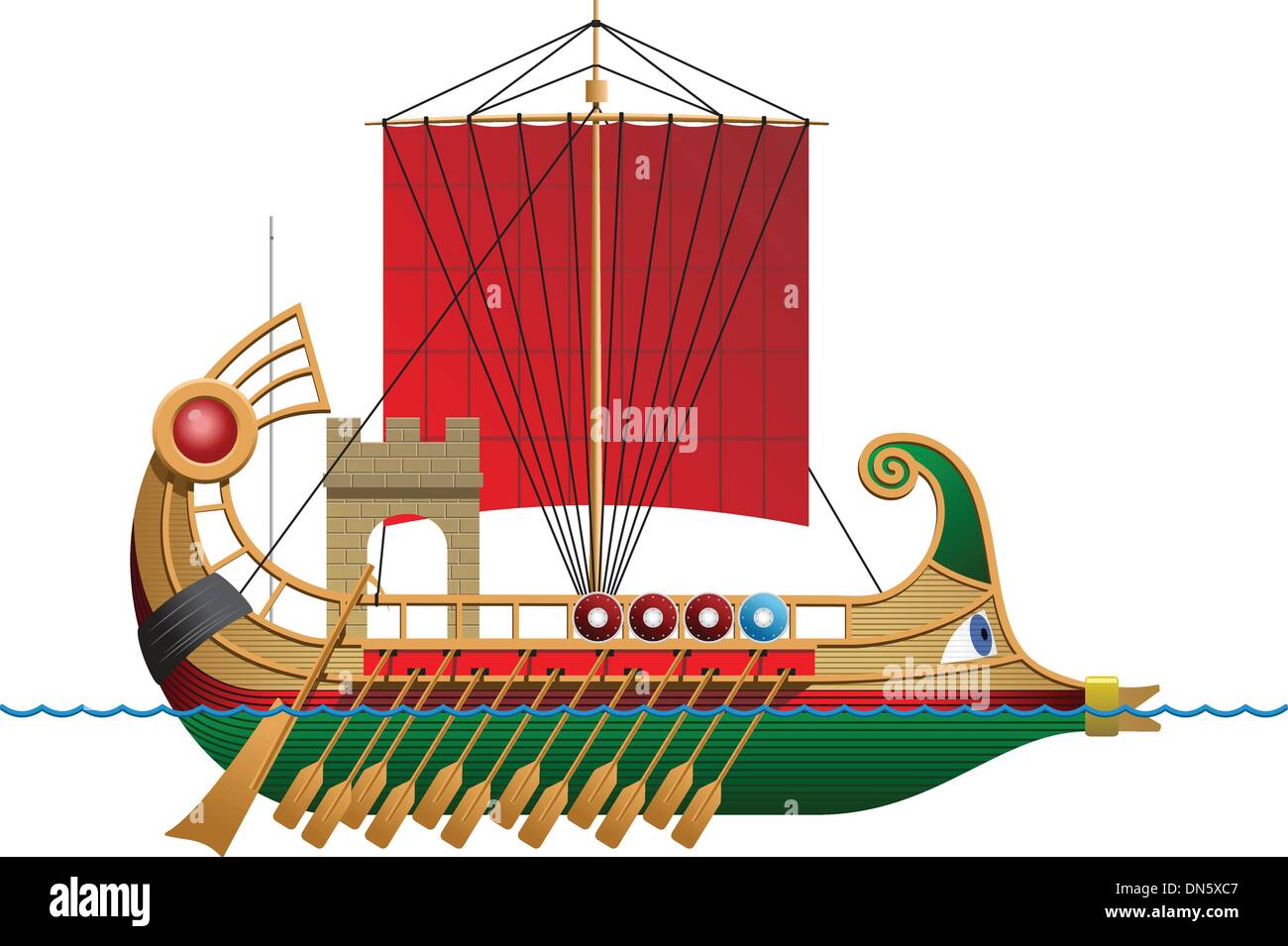 Bireme Stock Vectorhttps://www.alamy.com/image-license-details/?v=1https://www.alamy.com/bireme-image64669367.html
Bireme Stock Vectorhttps://www.alamy.com/image-license-details/?v=1https://www.alamy.com/bireme-image64669367.htmlRFDN5XC7–Bireme
 Iberian Peninsula. Ancient History. Phoenicians. Figures 2 to 5: illustrations inspired by antiquities from the Cerro de los Santos. Figure 6: Phoenician from a small lamp in the Museum of Tarragona. Chromolithography. Historia General de España, by Modesto Lafuente. Volume I. Published in Barcelona, 1877. Stock Photohttps://www.alamy.com/image-license-details/?v=1https://www.alamy.com/iberian-peninsula-ancient-history-phoenicians-figures-2-to-5-illustrations-inspired-by-antiquities-from-the-cerro-de-los-santos-figure-6-phoenician-from-a-small-lamp-in-the-museum-of-tarragona-chromolithography-historia-general-de-espaa-by-modesto-lafuente-volume-i-published-in-barcelona-1877-image465734807.html
Iberian Peninsula. Ancient History. Phoenicians. Figures 2 to 5: illustrations inspired by antiquities from the Cerro de los Santos. Figure 6: Phoenician from a small lamp in the Museum of Tarragona. Chromolithography. Historia General de España, by Modesto Lafuente. Volume I. Published in Barcelona, 1877. Stock Photohttps://www.alamy.com/image-license-details/?v=1https://www.alamy.com/iberian-peninsula-ancient-history-phoenicians-figures-2-to-5-illustrations-inspired-by-antiquities-from-the-cerro-de-los-santos-figure-6-phoenician-from-a-small-lamp-in-the-museum-of-tarragona-chromolithography-historia-general-de-espaa-by-modesto-lafuente-volume-i-published-in-barcelona-1877-image465734807.htmlRM2J1M1DY–Iberian Peninsula. Ancient History. Phoenicians. Figures 2 to 5: illustrations inspired by antiquities from the Cerro de los Santos. Figure 6: Phoenician from a small lamp in the Museum of Tarragona. Chromolithography. Historia General de España, by Modesto Lafuente. Volume I. Published in Barcelona, 1877.
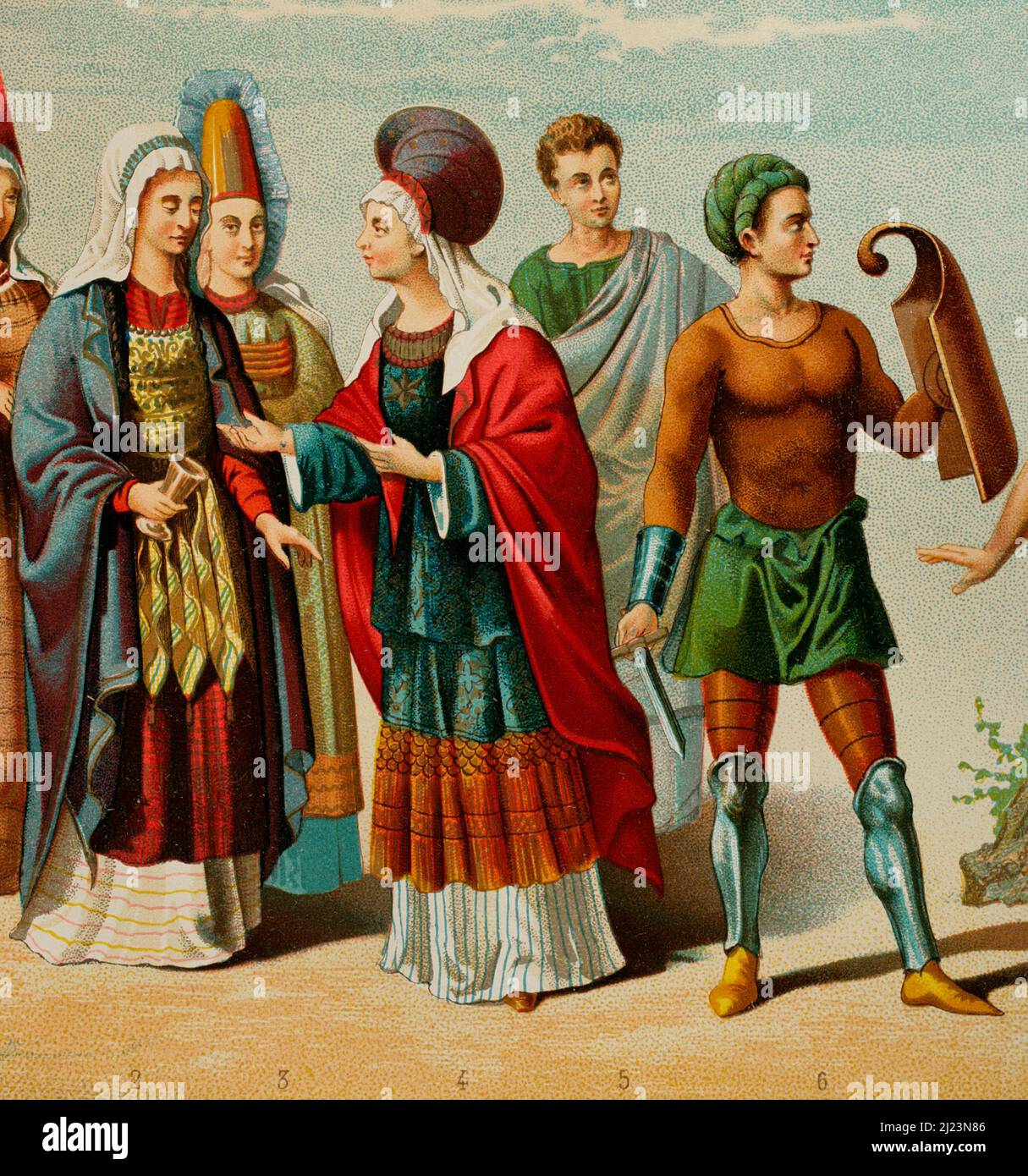 Iberian Peninsula. Ancient History. Phoenicians. Figures 2 to 5: illustrations inspired by antiquities from the Cerro de los Santos. Figure 6: Phoenician from a small lamp in the Museum of Tarragona. Chromolithography. Historia General de España, by Modesto Lafuente. Volume I. Published in Barcelona, 1877. Stock Photohttps://www.alamy.com/image-license-details/?v=1https://www.alamy.com/iberian-peninsula-ancient-history-phoenicians-figures-2-to-5-illustrations-inspired-by-antiquities-from-the-cerro-de-los-santos-figure-6-phoenician-from-a-small-lamp-in-the-museum-of-tarragona-chromolithography-historia-general-de-espaa-by-modesto-lafuente-volume-i-published-in-barcelona-1877-image465991798.html
Iberian Peninsula. Ancient History. Phoenicians. Figures 2 to 5: illustrations inspired by antiquities from the Cerro de los Santos. Figure 6: Phoenician from a small lamp in the Museum of Tarragona. Chromolithography. Historia General de España, by Modesto Lafuente. Volume I. Published in Barcelona, 1877. Stock Photohttps://www.alamy.com/image-license-details/?v=1https://www.alamy.com/iberian-peninsula-ancient-history-phoenicians-figures-2-to-5-illustrations-inspired-by-antiquities-from-the-cerro-de-los-santos-figure-6-phoenician-from-a-small-lamp-in-the-museum-of-tarragona-chromolithography-historia-general-de-espaa-by-modesto-lafuente-volume-i-published-in-barcelona-1877-image465991798.htmlRM2J23N86–Iberian Peninsula. Ancient History. Phoenicians. Figures 2 to 5: illustrations inspired by antiquities from the Cerro de los Santos. Figure 6: Phoenician from a small lamp in the Museum of Tarragona. Chromolithography. Historia General de España, by Modesto Lafuente. Volume I. Published in Barcelona, 1877.
 Mother and children sitting in the hippodrome in Tyre Lebanon Stock Photohttps://www.alamy.com/image-license-details/?v=1https://www.alamy.com/stock-photo-mother-and-children-sitting-in-the-hippodrome-in-tyre-lebanon-15270818.html
Mother and children sitting in the hippodrome in Tyre Lebanon Stock Photohttps://www.alamy.com/image-license-details/?v=1https://www.alamy.com/stock-photo-mother-and-children-sitting-in-the-hippodrome-in-tyre-lebanon-15270818.htmlRMAMHREY–Mother and children sitting in the hippodrome in Tyre Lebanon
 Byblos street, Unesco World Heritage Site, Jbail, Lebanon Stock Photohttps://www.alamy.com/image-license-details/?v=1https://www.alamy.com/stock-photo-byblos-street-unesco-world-heritage-site-jbail-lebanon-37835486.html
Byblos street, Unesco World Heritage Site, Jbail, Lebanon Stock Photohttps://www.alamy.com/image-license-details/?v=1https://www.alamy.com/stock-photo-byblos-street-unesco-world-heritage-site-jbail-lebanon-37835486.htmlRMC5FFFA–Byblos street, Unesco World Heritage Site, Jbail, Lebanon
 Saint Barbara; Poncher Hours, about 1500. Stock Photohttps://www.alamy.com/image-license-details/?v=1https://www.alamy.com/saint-barbara-poncher-hours-about-1500-image631195415.html
Saint Barbara; Poncher Hours, about 1500. Stock Photohttps://www.alamy.com/image-license-details/?v=1https://www.alamy.com/saint-barbara-poncher-hours-about-1500-image631195415.htmlRM2YJWC5B–Saint Barbara; Poncher Hours, about 1500.
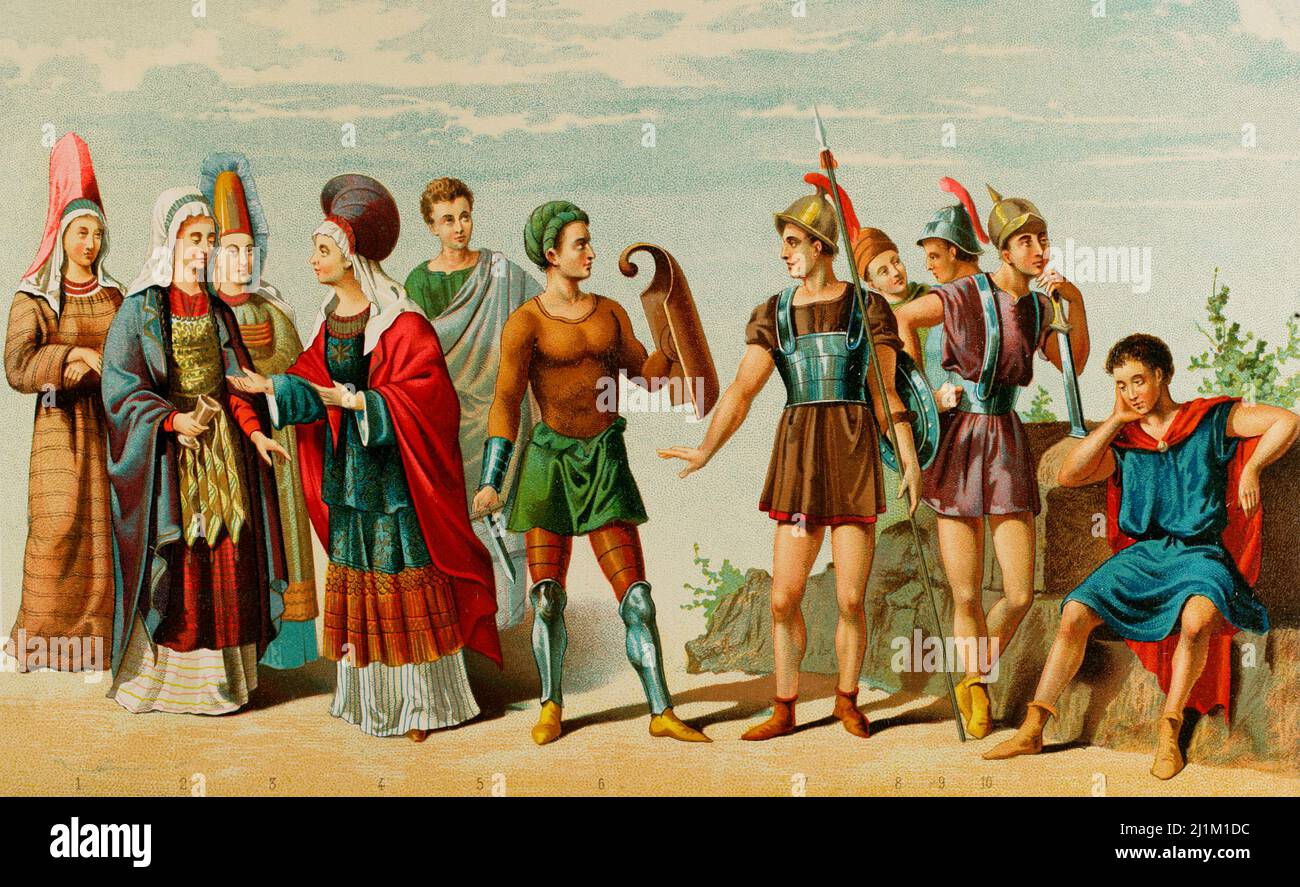 Iberian Peninsula. Ancient History. From left to right; figures 1 to 6: Phoenicians, figures 7 to 11: Celtiberians. Chromolithography. Historia General de España, by Modesto Lafuente. Volume I. Published in Barcelona, 1877. Stock Photohttps://www.alamy.com/image-license-details/?v=1https://www.alamy.com/iberian-peninsula-ancient-history-from-left-to-right-figures-1-to-6-phoenicians-figures-7-to-11-celtiberians-chromolithography-historia-general-de-espaa-by-modesto-lafuente-volume-i-published-in-barcelona-1877-image465734792.html
Iberian Peninsula. Ancient History. From left to right; figures 1 to 6: Phoenicians, figures 7 to 11: Celtiberians. Chromolithography. Historia General de España, by Modesto Lafuente. Volume I. Published in Barcelona, 1877. Stock Photohttps://www.alamy.com/image-license-details/?v=1https://www.alamy.com/iberian-peninsula-ancient-history-from-left-to-right-figures-1-to-6-phoenicians-figures-7-to-11-celtiberians-chromolithography-historia-general-de-espaa-by-modesto-lafuente-volume-i-published-in-barcelona-1877-image465734792.htmlRM2J1M1DC–Iberian Peninsula. Ancient History. From left to right; figures 1 to 6: Phoenicians, figures 7 to 11: Celtiberians. Chromolithography. Historia General de España, by Modesto Lafuente. Volume I. Published in Barcelona, 1877.
 Phoenician art. Cyprus. Statue of a priest. Late sixth century BC. Archaic Period. Limestone. It comes from Golgoi (Cyprus). Metropolitan Museum of Art. New York. United States. Stock Photohttps://www.alamy.com/image-license-details/?v=1https://www.alamy.com/phoenician-art-cyprus-statue-of-a-priest-late-sixth-century-bc-archaic-period-limestone-it-comes-from-golgoi-cyprus-metropolitan-museum-of-art-new-york-united-states-image220316541.html
Phoenician art. Cyprus. Statue of a priest. Late sixth century BC. Archaic Period. Limestone. It comes from Golgoi (Cyprus). Metropolitan Museum of Art. New York. United States. Stock Photohttps://www.alamy.com/image-license-details/?v=1https://www.alamy.com/phoenician-art-cyprus-statue-of-a-priest-late-sixth-century-bc-archaic-period-limestone-it-comes-from-golgoi-cyprus-metropolitan-museum-of-art-new-york-united-states-image220316541.htmlRMPPC7YW–Phoenician art. Cyprus. Statue of a priest. Late sixth century BC. Archaic Period. Limestone. It comes from Golgoi (Cyprus). Metropolitan Museum of Art. New York. United States.
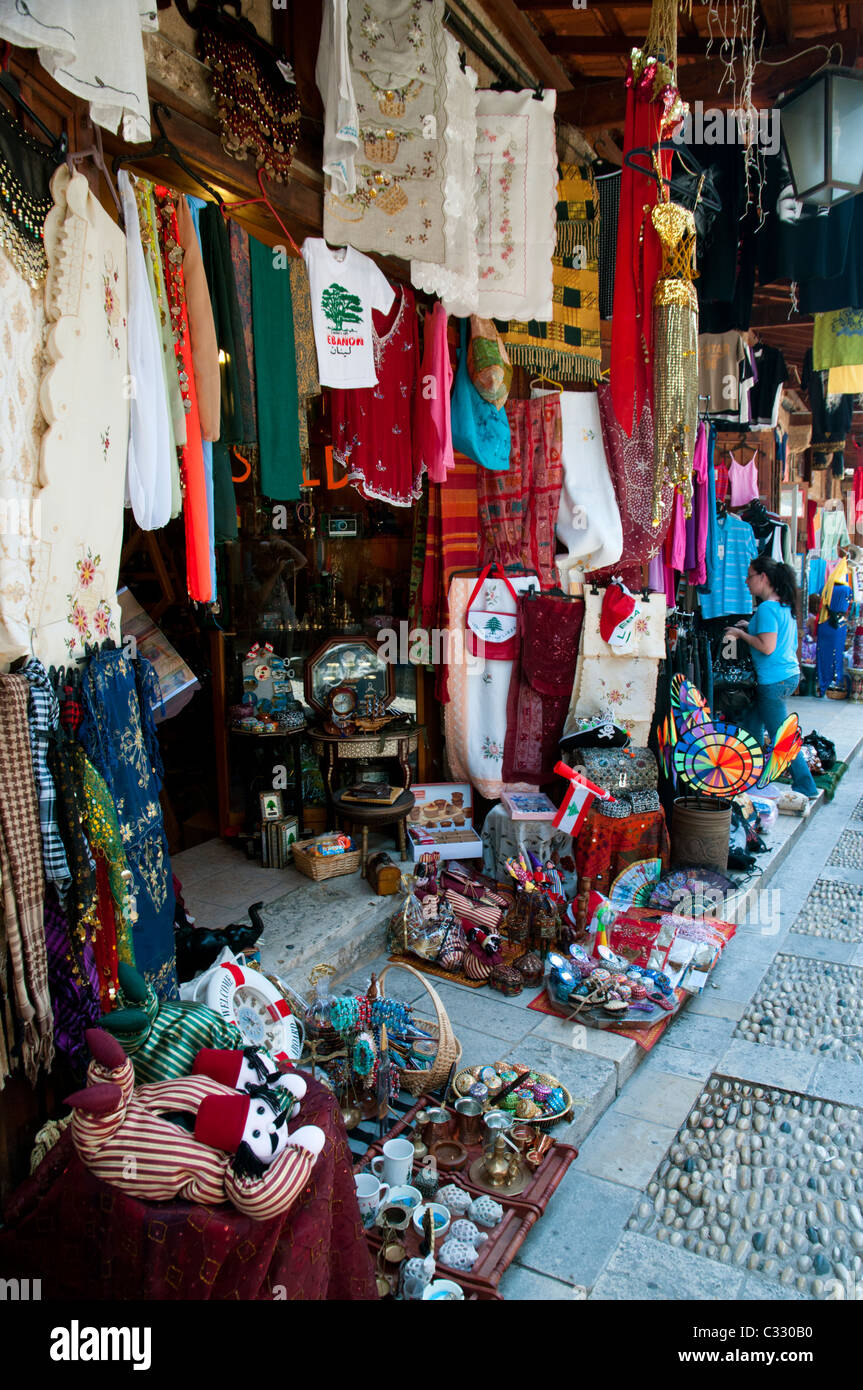 Market Souk in Byblos, Unesco World Heritage Site, Jbail, Lebanon Stock Photohttps://www.alamy.com/image-license-details/?v=1https://www.alamy.com/stock-photo-market-souk-in-byblos-unesco-world-heritage-site-jbail-lebanon-36330868.html
Market Souk in Byblos, Unesco World Heritage Site, Jbail, Lebanon Stock Photohttps://www.alamy.com/image-license-details/?v=1https://www.alamy.com/stock-photo-market-souk-in-byblos-unesco-world-heritage-site-jbail-lebanon-36330868.htmlRMC330B0–Market Souk in Byblos, Unesco World Heritage Site, Jbail, Lebanon
 Phoenician art. Cyprus. Bearded man with votive offerings. Ca. 475-450 BC. Classical Period. Limestone. Comes from Golgoi (Cyprus). Metropolitan Museum of Art. New York. United States. Stock Photohttps://www.alamy.com/image-license-details/?v=1https://www.alamy.com/phoenician-art-cyprus-bearded-man-with-votive-offerings-ca-475-450-bc-classical-period-limestone-comes-from-golgoi-cyprus-metropolitan-museum-of-art-new-york-united-states-image220340972.html
Phoenician art. Cyprus. Bearded man with votive offerings. Ca. 475-450 BC. Classical Period. Limestone. Comes from Golgoi (Cyprus). Metropolitan Museum of Art. New York. United States. Stock Photohttps://www.alamy.com/image-license-details/?v=1https://www.alamy.com/phoenician-art-cyprus-bearded-man-with-votive-offerings-ca-475-450-bc-classical-period-limestone-comes-from-golgoi-cyprus-metropolitan-museum-of-art-new-york-united-states-image220340972.htmlRMPPDB4C–Phoenician art. Cyprus. Bearded man with votive offerings. Ca. 475-450 BC. Classical Period. Limestone. Comes from Golgoi (Cyprus). Metropolitan Museum of Art. New York. United States.
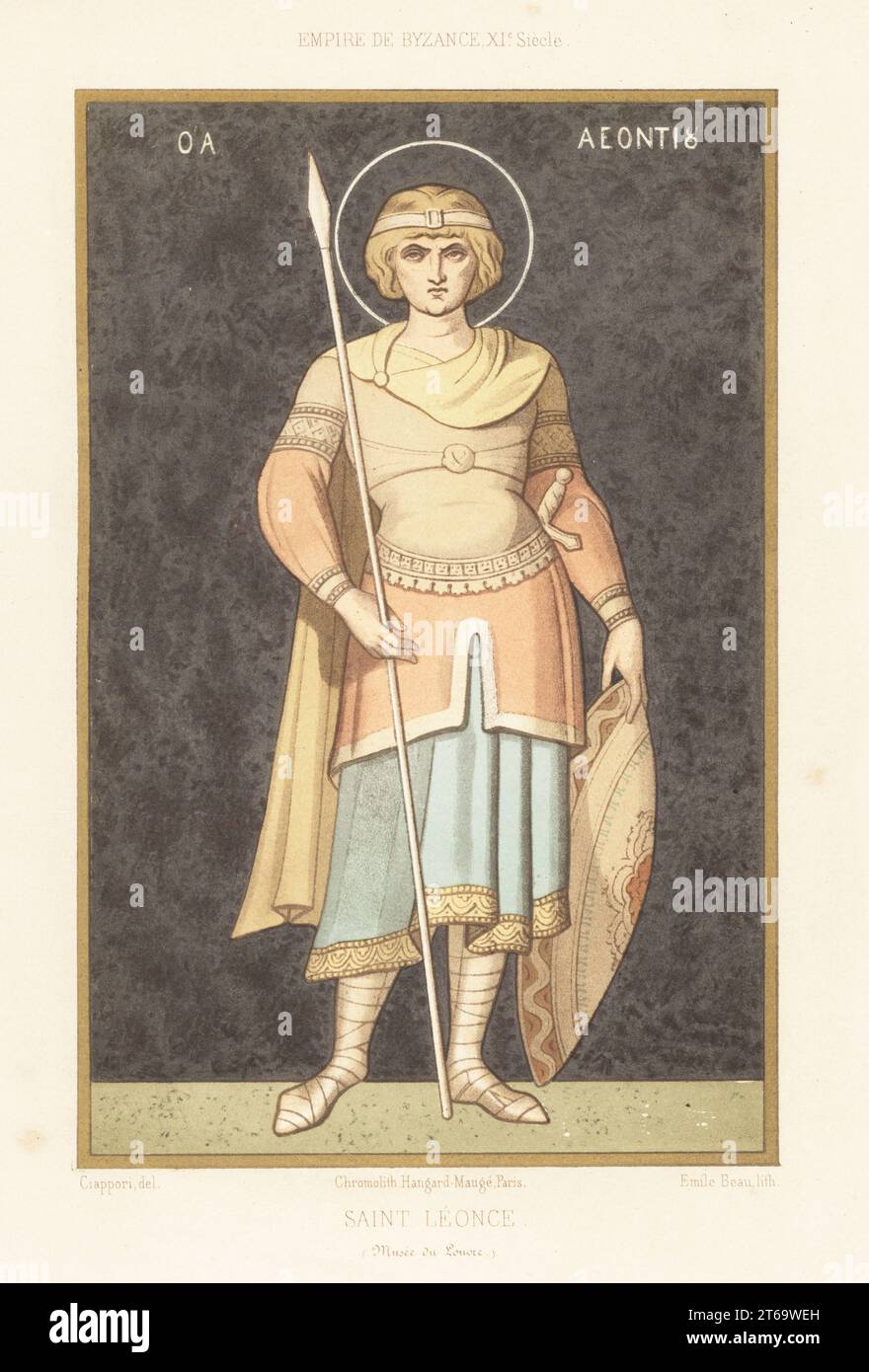 Saint Leonce of Tripoli, Phoenician soldier and martyr, 4th century. In Byzantine military costume of the 11th century. From a painting by Dominique Papety made in the Agia Lavra Monastery, Mt. Athos, now in the Louvre. Saint Leonce, Empire de Byzance, XIe Siecle. Chromolithograph by Emile Beau after an illustration by Claudius Joseph Ciappori from Charles Louandres Les Arts Somptuaires, The Sumptuary Arts, Hangard-Mauge, Paris, 1858. Stock Photohttps://www.alamy.com/image-license-details/?v=1https://www.alamy.com/saint-leonce-of-tripoli-phoenician-soldier-and-martyr-4th-century-in-byzantine-military-costume-of-the-11th-century-from-a-painting-by-dominique-papety-made-in-the-agia-lavra-monastery-mt-athos-now-in-the-louvre-saint-leonce-empire-de-byzance-xie-siecle-chromolithograph-by-emile-beau-after-an-illustration-by-claudius-joseph-ciappori-from-charles-louandres-les-arts-somptuaires-the-sumptuary-arts-hangard-mauge-paris-1858-image571847657.html
Saint Leonce of Tripoli, Phoenician soldier and martyr, 4th century. In Byzantine military costume of the 11th century. From a painting by Dominique Papety made in the Agia Lavra Monastery, Mt. Athos, now in the Louvre. Saint Leonce, Empire de Byzance, XIe Siecle. Chromolithograph by Emile Beau after an illustration by Claudius Joseph Ciappori from Charles Louandres Les Arts Somptuaires, The Sumptuary Arts, Hangard-Mauge, Paris, 1858. Stock Photohttps://www.alamy.com/image-license-details/?v=1https://www.alamy.com/saint-leonce-of-tripoli-phoenician-soldier-and-martyr-4th-century-in-byzantine-military-costume-of-the-11th-century-from-a-painting-by-dominique-papety-made-in-the-agia-lavra-monastery-mt-athos-now-in-the-louvre-saint-leonce-empire-de-byzance-xie-siecle-chromolithograph-by-emile-beau-after-an-illustration-by-claudius-joseph-ciappori-from-charles-louandres-les-arts-somptuaires-the-sumptuary-arts-hangard-mauge-paris-1858-image571847657.htmlRM2T69WEH–Saint Leonce of Tripoli, Phoenician soldier and martyr, 4th century. In Byzantine military costume of the 11th century. From a painting by Dominique Papety made in the Agia Lavra Monastery, Mt. Athos, now in the Louvre. Saint Leonce, Empire de Byzance, XIe Siecle. Chromolithograph by Emile Beau after an illustration by Claudius Joseph Ciappori from Charles Louandres Les Arts Somptuaires, The Sumptuary Arts, Hangard-Mauge, Paris, 1858.
 GREEK ART. REPUBLIC OF ALBANIA. Statue of Artemis, goddess of hunting. Found during the excavation of Phoenician in the year 2003-04. III-I century B.C. Ruins of Butrint Museum. Stock Photohttps://www.alamy.com/image-license-details/?v=1https://www.alamy.com/greek-art-republic-of-albania-statue-of-artemis-goddess-of-hunting-found-during-the-excavation-of-phoenician-in-the-year-2003-04-iii-i-century-bc-ruins-of-butrint-museum-image209621747.html
GREEK ART. REPUBLIC OF ALBANIA. Statue of Artemis, goddess of hunting. Found during the excavation of Phoenician in the year 2003-04. III-I century B.C. Ruins of Butrint Museum. Stock Photohttps://www.alamy.com/image-license-details/?v=1https://www.alamy.com/greek-art-republic-of-albania-statue-of-artemis-goddess-of-hunting-found-during-the-excavation-of-phoenician-in-the-year-2003-04-iii-i-century-bc-ruins-of-butrint-museum-image209621747.htmlRMP512JY–GREEK ART. REPUBLIC OF ALBANIA. Statue of Artemis, goddess of hunting. Found during the excavation of Phoenician in the year 2003-04. III-I century B.C. Ruins of Butrint Museum.
 Iberian Peninsula. Ancient History. From left to right; figures 1 to 6: Phoenicians, figures 7 to 11: Celtiberians. Chromolithography. Historia General de España, by Modesto Lafuente. Volume I. Published in Barcelona, 1877. Stock Photohttps://www.alamy.com/image-license-details/?v=1https://www.alamy.com/iberian-peninsula-ancient-history-from-left-to-right-figures-1-to-6-phoenicians-figures-7-to-11-celtiberians-chromolithography-historia-general-de-espaa-by-modesto-lafuente-volume-i-published-in-barcelona-1877-image465991819.html
Iberian Peninsula. Ancient History. From left to right; figures 1 to 6: Phoenicians, figures 7 to 11: Celtiberians. Chromolithography. Historia General de España, by Modesto Lafuente. Volume I. Published in Barcelona, 1877. Stock Photohttps://www.alamy.com/image-license-details/?v=1https://www.alamy.com/iberian-peninsula-ancient-history-from-left-to-right-figures-1-to-6-phoenicians-figures-7-to-11-celtiberians-chromolithography-historia-general-de-espaa-by-modesto-lafuente-volume-i-published-in-barcelona-1877-image465991819.htmlRM2J23N8Y–Iberian Peninsula. Ancient History. From left to right; figures 1 to 6: Phoenicians, figures 7 to 11: Celtiberians. Chromolithography. Historia General de España, by Modesto Lafuente. Volume I. Published in Barcelona, 1877.